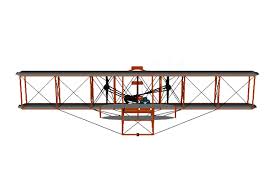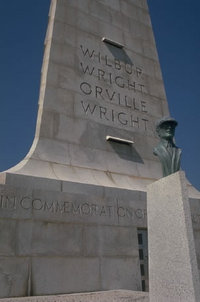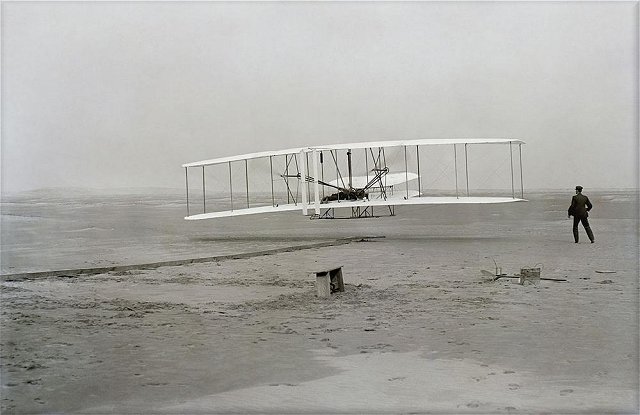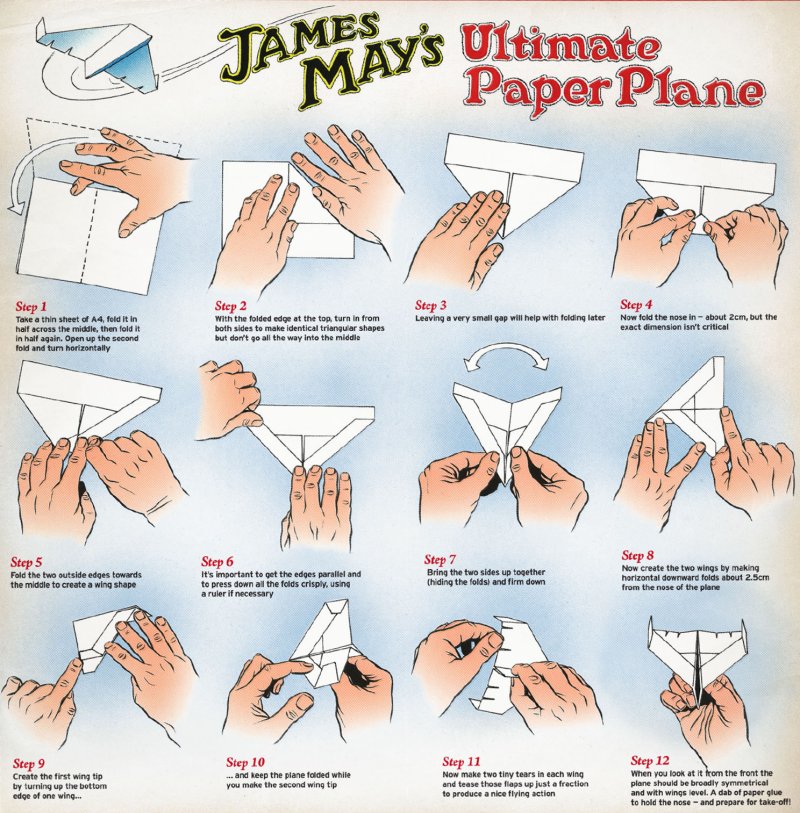



|
BOOKS&THINGS is the section of this web site where I review and recommend books, articles, or other aviation related information from other web sites. I feel this material is particularly interesting and/or informative. What do you think? I would enjoy receiving any feedback on these references you might like to offer.
|
Yesterday while at the local bookstore I picked up a delightful little book (literally). "Slipping the Surly Bonds", is written by Dave English who is currently a contributing editor at Airways magazine.
"A fitting crown for the 'Century of Flight,' this unique collection of the most compelling words ever written or spoken about flying spotlights one of humankind's greatest, most enduring, and most spectacular accomplishments-the gravity-defying conquest of the skies.
Gathered together for the first time, these quotations convey the drama, achievement, and pure thrill of flying. Some touch you with the pathos of doomed heros and heroines and the brave struggles of storied aviators. Others capture with humor the fun of flight. You'll find predictions of the future of aviation, luxury replica watches air combat experiences, historical anecdotes, wisdom on safety, thoughts by and about women pilots, and much, much more-all lovingly selected to inspire and uplift flyers and non-flyers alike.
A word of caution, however. If you're buying this book for yourself, be sure to write your name inside the cover. Slipping the Surly Bonds is one of those rare books that you just won't be able to resist sharing with friends!"
I was born June 22, 1937. Powered flight occurred for the first time not even 35 years before.
A mere ten years before I was born, on May 20, 1927, Charles Lindbergh took off for Paris and became the first person to fly the Atlantic ocean, non-stop. The day I was born Amelia Earhart was in Bandoeng on the island of Java awaiting repairs to her Lockeed Electra. Amelia and her navigator Fred Noonan left Bandoeng about two o'clock in the afternoon on June 24, 1937 for the next leg of her notorious round the world flight which, of course, she never completed.
The greatest thing in the air in 1937 was the Douglas DC-3 airliner. All metal, twenty-one passengers, 185 miles per hour (160 knots), at ten thousand feet!
I still remember the period after World War II as a child living in Chicago, when one morning my father read to me an article in the newspaper saying that on a certain day at a certain time an airplane without a propeller called a "jet" would be flying over the area. Me and a friend, without permission of course, climbed a long dangerous ladder to the roof of our apartment building to see if we could witness this monumental event. After all by this time I was eight or ten years old and already the formost airplane authority in the neighborhood. As we lay on our backs on the roof looking up searching the sky we first heard a sound we had not heard before, and then, so high that it appeared very small this jet astonished us. How was it possible for an airplane to fly without a propeller?
During a trip to the east coast in September 2005, on which my wife and I took the time to visit the Wright Brothers memorial at Kitty Hawk, North Carolina, I discovered what the Wright brothers actually did just after the turn of the 20th century and how truly astounding what the synergy of these two brothers produced. The impact of what they gave to the world, however reluctantly, has to be judged, as many would argue, the greatest accomplishment of the 20th century.
The Wright Brothers where actually inspired to take up the quest for a flying machine at a very young age.
"The spread of windmills (in England and France in 1170) inspired a new toy, the pinwheel or petit moulinet à vent, which first appeared in illustrations in the thirteenth-and fouteenth-century manuscripts. These "little windmills," in turn, inspired the invention of the first powered flying machine, a helicopter toy first seen in a Flemish manuscript dating to 1325. In its original form, the toy consisted of a spindle with a vertical hole in which to place a shaft topped with a horizontal pinwheel. The operator held the spindle in one hand and pulled a string wrapped around the shaft with the other, sending the shaft and blades twirling up into the air. ...The little rotary-wing toy appears in a number of early modern portraits of children, and in paintings such as Pieter Brueghel's Children's Games. ...This old toy literally changed the course of history a decade later, when it fell into the hands of Sir George Cayley (1773-1857). In 1796, ...the twenty-three-year-old Englishman produced his own simplified version of the helicopter toy, he called a Chinese Top. Apparently, Sir George had no notion of the toy's deep roots in the European past. Alphonse Pénaud (1850-1880), ...transformed the the old toy into a sophisticated flying model powered by twisted rubber strands. Dubbed a hélicoptère and introduced in about 1870, the little Pénaud model held the world's altitude record for powered, propeller-driven flight, climbing to altitudes of up to fifty feet and remaining in the air for as long as twenty-six seconds. In 1878, a Pénaud helicopter toy caught the eye of an American churchman, who bought one for his two youngest sons. 'Our first interest began when we were children,' Orville Wright explained. 'Father brought home to us a small toy actuated by a rubber spring which would lift itself into the air.' We do not know where the Bishop Milton Wright found the helicopter, or what it cost. Its impact is clear, however. Eleven-year-old Wilbur and his seven-year-old brother Orville sent the little gadget aloft time after time. ...'We built a number of copies of this toy, which flew successfully,' Wilbur explained. Miss Ida Palmer, Orville's second-grade teacher, discovered the boy assembling one of the helicopters instead of finishing an assignment. When asked what he was doing, Orville explained that he was building a model of the flying machine that might one day enable him to fly with his brother."
The rest, as "they" say, is history!
"On December 17, 1903, Wilbur and Orville Wright accomplished what no one before them had the insight to recognize and tackle: they worked out a means of controlling an aircraft aerodynamically by deflecting the wing and tail surfaces, as Wilbur had seen the birds do. In this respect, they were far ahead not only of their predecessors but all their contemporaries as well-including some of the worlds top scientists. The secret to their success was that they learned to fly before attempting to mount an engine on their glider. They learned how to use aerodynamic surfaces to control their airplane in a satisfactory manner, and, together with the experience they developed as pilots of their kites and gliders, they were able to fly their plane without difficulty when they finally equipped it with a gas-powered motor. They thus "invented" the airplane by first learning how to control a flying machine in the dynamic element of the air. It took a rare combination to achieve what they did-not only pioneering thinking, but marvelously clear and logical thinking as well. The historic flight of the Wright airplane a Kitty Hawk in 1903 culminated a long, faltering search for basic aerodynamic knowledge, a winding and irregular path that runs far back into the dawn of human experience, back even to our ancestor's prehistoric facination with the flight of birds. No doubt, humankind dreamed about flying as soon as dreaming began. When civilizations arose, men and women imagined gods in the sky and gave them wings. Thus, no matter what ancient civilization one looks at, its gods could fly. The power of flight denied to mortals we envisioned in our immortal dieties. They lived in the heavens above; they moved across the sky in golden chariots; they soared majestically in and above the clouds. While the materials needed to fabricate a craft resembling a modern hang glider were available thousands of years ago. unquestionably one of the major reasons that mechanical flight did not happen for millennia rested in the basic intuitive misconception that in order for humans to fly, we needed to imitate the birds. But exactly how did birds accomplish flight? Before modern scientific observations with high-speed cameras, and more importantly, before the dawn of a mathematically derived and rational theory of aerodynamics, naked-eye observations of birds in flight fostered a wrongheaded belief in flaping wings. From the gossamer wings crafted in ancient Greek mythology by Daedalus and Icarus to the fanciful ornithopter designed by Leonardo da Vinci during the Renaissance, the best idea anyone could come up with was to mimic the a flapping wing structure and adapt it for human use. This path to heavier-than-air flight proved not only ignominiously unsuccessful, but also fatal. Donning makeshift wings of wood, feathers, and cloth, a handful of foolish men in the Middle Ages (we will never know exactly how many), jumped to their deaths from the tops of cathedral towers and castle walls, flapping away without a whit of real aerodynamic understanding.
It is important to understand how the Wrights went their own special way in pursuit of inventing the airplane. Not that they ignored all the work others had been doing. In fact, one of the first things after deciding to address the problems of flight in 1896 was to collect all the aeronautical information that was available. First, they exhausted the collections at the Dayton Public library, and then wrote to (Octave) Chanute, who was kind enough to write back and advise them to learn how to glide before they tried powered flight. Aware of (Samual) Langley's work, they also wrote to the Smithsonian Institution, which sent them a number of articles, including works by both Langley and (Otto) Lilienthal. Once they had digested this knowledge, however, they approached technical problems from their own unique perspective and came up with their own way of solving them.
The most significant example of this crucial charactistic of the Wrights concerned the decisive matter of control. They did something that no airplane pioneer up to their time had dome: they isolated control of an airplane as the main problem that needed attention. Lilienthal, Chanute, and Langley had obviously designed wings that were able to lift machines into the air, and while there were many aerodynamic improvements yet to come regarding lift, the invention of the airplane did not have to wait for them. Neither did the problem of propulsion overly concern the Wrights, because mechanics all over the country were developing small, lightweight internal combustion engines for automobiles and motorcycles. When they needed an engine, the Wrights knew the technology would be there. That left the issue of pilot control, the very problem that had killed Lilienthal (in a gliding accident in October, 1896) and the aspect to which nobody else had given much priority.
The Wright's thought process about control ran totally against the grain of current thinking, and in hindsight it is clear that this was precisely why they eventually succeeded where others failed. Since Lilienthal, the great "Flying Man," had died because not even he was able to control his aircraft, conventional wisdom reasoned that what was needed was an inherently stable machine. That was the line of thinking followed by both Chanute and Langely, amoung others. The Wrights turned this logic on its head. They cared little about a flying machine's stability and instead focused on the critical aspect of making it controllable. Their intimacy with bicycle technology no doubt influenced them greatly on this matter, for the bicycle is anything but an inherently stable machine. The Wrights believed that the airplane would need be the same sort of dynamically interactive device as a bicycle: unstable on its own, but completely controllable and virtually automatic in the hands of an experienced operator. The key was designing control features into the airplane that a pilot could easily and effectively manage."
What Wilbur and Orville accomplished borders on the miraculous. Nobody had ever built a viable powered airplane before; they learned how to do it as they went. When they started they didn't even know how to fly an airplane; they taught themselves as they went. When they needed an engine to power their new airplane the went back to Dayton and built one!
Quote from Tom D. Crouch, Wings, (New York, London: W.W. Norton, 2003), 635-636
Now you too can show an aspiring young son or daughter how to build the "Ultimate Paper Airplane." Simply follow the instructions in the diagram below. Enjoy.
SLIPPING THE SURLY BONDS

THE WRIGHT BROTHERS



Wilbur Wright
1867-1912
Orville Wright
1871-1948
Quote from Tom D. Crouch, Wings, (New York, London: W.W. Norton, 2003), 25-26
Quote from James R. Hansen, The Bird Is on the Wing: Aerodynamics and the Progress of the American Airplane, (College Station, TX: Texas A&M University Press, 2004), 15-16
"The year 1896 thus was pivotal in the history of aeronautics. In that year, two brothers in Ohio, self-trained designers without high school diplomas, turned their attention away from their print shop and bycycle business in order to take a crack at inventing the airplane. These two unique individuals, Wilbur (1867-1912) and Orville (1871-1948) Wright, brought not only fresh perspectives and new energy to the fledging field of flight research, but also one of the most protean collaborations of genuine talent in the history of invention. Writing shortly before his untimely death, Wilbur Wright offered the following insight into the fruitful relationship that sustained them in their work and jointly magified their respective abilities: "From the time we were little children my brother Orville and myself lived together, played together, worked together and, in fact, thought together. We usually owned all of our toys in common, talked over our thoughts and aspirations so that nearly everything that was done in our lives has been the result of conversations, suggestions and discusssions between us." Without this creative synergism, it is impossible to imagine them inventing the airplane.
Quote from James R. Hansen, The Bird Is on the Wing: Aerodynamics and the Progress of the American Airplane, (College Station, TX: Texas A&M University Press, 2004), 33-34
"Ironically, even the Wright's found it impossible to predict the future of the technology they introduced to the world. "No airship will ever fly from New york to Paris," Wilbur remarked in 1909. "No engine can run ... for four days without stopping." Nor did he hold out much hope for large aircraft. "The airship will always be a special messenger," he predicted, "never a load-carrier." His brother Orville did not "believe that the airplane will ever take the place of trains or steamships for the carrying of passengers."

THE ULTIMATE PAPER PLANE


January 1, 2006
©Copyright steveBERRY 1998.